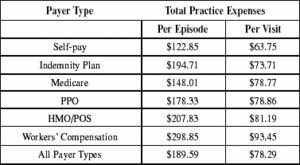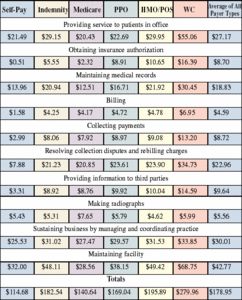The authors discovered that the answer is a resounding "Yes!" In fact, workers' compensation expenses were more than double that of self-payers.
The study took place in Texas, where the investigators selected a large orthopedic practice and followed the progress of 518 consecutive patients, using fairly straightforward methodology:
"The various practice expenses were calculated on an individual patient basis with use of the method of activity-based costing.2,3,4
"Data for these activities were collected via a time-motion study on a per-patient basis. All employees were issued a study notebook and a stopwatch. The notebook contained individual data sheets for each patient, so that the employees could record the time spent (to the nearest minute) on any and all activities related to the particular patient's care."
When the practice expenses (excluding payment to the provider) were calculated and the math was completed, the investigators discovered that practice expenses change dramatically based on payer type:
According to these results, practice expenses for workers' compensation were 2.43 times greater than for self-pay on a per-episode basis, or 46 percent higher on a per-office-visit basis.
The authors also provided a breakdown of these differences according to the type of practice expenses. As orthopedic and chiropractic practices differ, only the relevant practice expenses are included in the table.
The value of this exercise was not lost on the investigators. They knew that if providers could objectively determine and demonstrate their practice expenses, they could negotiate more effectively with payers:
"The estimated total practice expense per episode of care by payer type reported in the present study is useful to orthopedic practices in discussions with payers about contracted fee schedules. Our findings allow an orthopedic practice to evaluate whether a negotiated reimbursement rate is adequate to provide services for the payer's population. In addition, specific third-party payers can be compared with other third-party payers within the same payer type, which may be useful when deciding whether renewal of a contract with a specific insurance company would be profitable.
"Both PPO and HMO/POS payers, for example, establish contracted reimbursement arrangements for orthopedic surgical services. The total practice expense associated with operative treatment of sports-related knee disorders for the average patient in the PPO group was $308.34 per episode of care. For the average patient in the HMO/POS group, the total practice expense was $336.83 per episode of care. Thus, the orthopedic group should negotiate a contracted arrangement with HMO/POS payers that will reimburse the additional $28.49 of practice expenses. "It is intriguing and counterintuitive that use of the HMO/POS providers, who promote their network as an effective method of controlling health-care costs, resulted in a 9.2-percent increase in orthopedic practice expenses compared with the PPO group and a 42.9-percent increase in expenses, compared with the self-pay group ($235.69 per episode of care)."
So, here we have an established method for determining the per-episode and per-visit practice expenses for a chiropractic practice based on "activity-based costing." I would venture to guess that if a state association commissioned a study of chiropractic practice expenses in its state, you would be surprised at the amount of time (or money) you would spend on meeting the requirements of various types of payers.
If you had the results of a statewide study like this for chiropractic, you would feel much more confident about what each patient visit really costs you before you pay yourself. (Remember, practice expenses do not include any money to you.)
Then, as the authors point out, you could better "evaluate whether a negotiated reimbursement rate is adequate to provide services for the payer's population." Armed with this information, you, too, will be able to better decide, "whether renewal of a contract with a specific insurance company would be profitable."
References
- Brinker M, O'Connor D, Woods G, et al. The effect of payer type on orthopaedic practice expenses. J Bone Joint Surg Am 2002 84:1816-1822.
- Carlomagno M, Draper V. Activity-based costing management in a private practice setting. Med Group Manage J 1997;44:68-70, 72, 78.
- Brinker MR, Pierce P, Siegel G. Development of a method to analyze orthopedic practice expenses. Clin Orthop 2000;372:302-13.
- Canby JB. Applying activity-based costing to health care settings. Healthcare Finance Manage 1995;49:50-2, 54-6.
DMP Jr.
Click here for more information about Donald M. Petersen Jr., BS, HCD(hc), FICC(h), Publisher.







